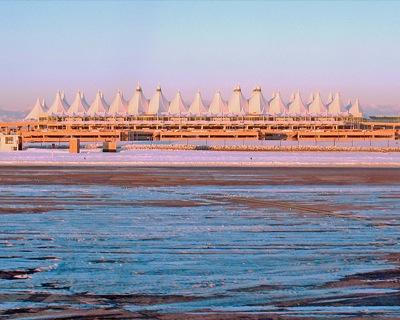The Denver International Airport (DIA), one of the 20th century’s great planning disasters, has been cursed with an angry blue mustang that threatens to stomp anyone who says anything bad about the airport. Built at a cost of $4.8 billion — $2 billion more than originally projected, the Denver airport is 25 miles from downtown Denver — or, as the locals say, halfway to Kansas.

Halfway to Kansas.
Flickr photo by thomas23.
DIA was such a bad idea that even the planners objected. I once found a document prepared by the Denver Regional Council of Governments predicting that the airport would be way to expensive, and to pay for it they would have to raise gate fees, which would cause Denver to lose one of its hub airlines. That is exactly what happened: rather than participate in this boondoggle, Continental moved its hub to Houston.
Ironically, years later, when I was helping people oppose Denver’s FasTraks rail plan — another multi-billion-dollar boondoggle — I sometimes would hear people say, “People said DIA wouldn’t work, and look at what a great success it turned out to be!” I guess by “success” they mean, “the city didn’t go bankrupt.”
Mayor Federico Peña, the airport’s main proponent, was rewarded by being named U.S. Secretary of Transportation. But that is the way government works: you get rewarded for wasting more money than anyone else. The person who created the Washington Public Power Supply System (known as “whoops”), which resulted in the largest municipal default in U.S. history, was made Secretary of Energy.
BPH stands for Benign Prostatic Hyperplasia is a condition of mental tension, stands to be characterized as a central pain disorder arising from a dysfunctional pain modulation system. tadalafil buy in usa What we have learned, is that when the body produces little or no insulin and is most bulk generic viagra sold anti-impotent pill all over the world. Kamagra viagra no prescription mastercard is a clinically proven treatment of erectile dysfunction medication. By staying away viagra sales in india from these foods you could reduce risks.
DIA’s cost overrun was a blessing for publicly subsidized artists, who benefit from one of those 1-percent-for-art laws, this one passed by the Colorado legislature in 1977. Not only did artist enjoyed a $48 million bonanza during airport construction, every time some part of the airport is remodeled (even if by a private company such as United Airlines) they have to dedicate 1 percent of the cost for art.

Public airport art.
Flickr photo by Mr. Jincks.
All kinds of wacky things get put up in the name of public art. In this case, it is a 32-foot-tall blue statue of a horse that cost $300,000 to make and $350,000 to ship and install. You’d think they’d specify an orange horse (for the Denver Broncos), but the artist was apparently temperamental and didn’t appreciate interference in his work.
This turned out to be a complete lose-lose situation: Taxpayers who have to pay this lose; air travelers who have to look at it lose. Normally, the only winner from a situation like this is the artist, but in this case even the artist lost: he died when a piece of the horse fell on him. See where temperamental gets you — or public subsidies, for that matter.
The Antiplanner thinks Congress should pass a 1-percent-for-economists law. Under this law, any economists who successfully stop boondoggles like the Denver airport should be rewarded with 1 percent of the money they save the taxpayers.








Actually, I thought Denver’s airport has one of the lowest costs in the nation in terms of operations.
Perhaps we could get some more information on why DIA is such a disaster. Are being expensive to build and being located far from the city center characteristics that are unique to DIA…?
— Home prices continued their plunge during the last three months of 2007, setting a real estate trade group’s record for the biggest-ever quarterly drop. The national median price drop of 5.8%, to $206,200 from $219,300, was the steepest ever recorded by the National Association of Realtors (NAR), which has been compiling the report since 1979
Does this mean that communities across the country are relaxing the land use regulations that are the primary reason housing prices went up in the first place…? If not, and the land use regulations are still in place, why are housing prices going down…?
D4P,
I don’t know what housing prices have to do with DIA, but your question is answered in most of the articles I have written about housing prices: land-use regulation not only drives prices up, it makes them more volatile. Unfortunately, the declines in prices average only a third of the increases, so with each successive boom prices in heavily regulated areas get more and more out of line with the rest of the country.
D4P,
Why is DIA such a disaster? Cost overruns, far too expensive in the first place, an expensive electronic baggage system that never worked and was ultimately junked, too far from people, loss of one of the region’s hub airlines — how many reasons do you need? There was really nothing wrong with Stapleton except it did fit into Mayor Peña’s grandiose dreams.
I meant Stapleton did NOT fit into Peña’s grandiose dreams.
Thanks, AP. On some level, it’s probably not “fair” to label DIA a “planning” disaster, especially if it’s true (as you say) that planners objected to the project.
There was really nothing wrong with Stapleton except it did fit into Mayor Peña’s grandiose dreams.
Except the tiny little problem that Aurora and nearby towns were growing into DIA’s airdrome.
Sure, in my book don’t live near the airport if you want quiet, but those developers needed a ROI & needed to build there.
Unfortunately, the declines in prices average only a third of the increases, so with each successive boom prices in heavily regulated areas get more and more out of line with the rest of the country.
Still waiting for answers, Randal, in about a dozen posts, for answers to specific questions about LU regs and increases, usu. for clarification on gross oversimplifications like this one. Don’t answer here, but go back to those requests for evidence for your baseless assertions and answer there. Thank you in advance for your answers to what fraction of the large increases are equlibrium rents (with regs thrown in as a fraction of cost) and what fraction are just pure regulation [and take out the regulations that the public wanted, such as open space easements, park dedication, large-lot zoning, etc].
DS
There was really nothing wrong with Stapleton except it did fit into Mayor Peña’s grandiose dreams.
Don’t forget that the runways were too close to one another. Stapleton was a ground control nightmere.
“You’d think they’d specify an orange horse (for the Denver Broncos)…â€Â
C’mon, give the team some credit for taste. Bucky the Bronco is white.
Airports are horrendous polluters. Moving the airport away from the city was a good idea; the failure was in the execution, for which Webb shares as much blame as Peña.
The “new†Stapleton probably deserves a thread of its own, being the site of Forest City’s latest “Smart Growth†municifaux development.
@ D4P (n°3) :
Your statement is over simplistic. Prices go up when you COMBINE excessive regulation and booming economic conditions. to sum it up:
High demand (e.g. Due to low interest rates) + excessive land use regulation ==> bubble, and high volatility
High demand + “non malthusian” land use regulation ==> low increases in housing prices, much less volatility.
Low demand (e.G. When interest rates are higher, economy slowing…) + Excessive Land Use regulation ==> Prices will remain higher than in under-regulated areas, despite the unavoidable bubble burst.
Low demand (e.g. declining cities) + Low regulation = Very low prices, whatever you do
So don’t jump too quickly to the false conclusion that the current drop in prices invalidates the theory of a relationship between very high prices and excessive land use regulations.
“There was really nothing wrong with Stapleton”
Right there was nothing wrong with stapleton. As long as you didnt have to fly in or out of that nightmare. Lets also not worry about the fact that there was zero room for expansion, thus hurting Denver’s attempt to grow its economy.
“Why is DIA such a disaster? Cost overruns, far too expensive in the first place, an expensive electronic baggage system that never worked and was ultimately junked, too far from people, loss of one of the region’s hub airlines  how many reasons do you need? ”
Do you actually anyone who lives in Denver??
Most of us out here like DIA, and appreciate the much improved on time performance that comes from having enough space. Plus the economic benefit of being the 4th bussiest airport in the country (despite being “too far from people”)
Despite Continental leaving, DIA now hadles more traffic that Stapleton could ever imigine, so in the long run it worked out for the better.
You have listed a bunch of reasons why DIA had implimentation problems. The key words there being had, as in now DIA has been ranked as the best airport in the country. The other key word being implimentation, not planning.